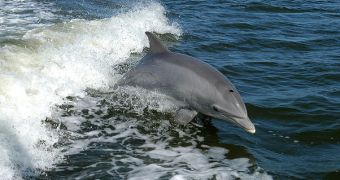In an interesting new research, experts were able to confirm the existence of numerous similarities between the cultural and social behaviors of chimpanzees and dolphins, despite the obvious, marked differences that exist between the two species.
It would appear that these similarities developed in spite of the fact that chimps and dolphins are separated by no less than 95 million years of evolution, not to mention their environments of choice.
Female chimps share most similarities with female dolphins. Both rear their young from an early age, protecting the offspring from harm, and making sure they are well prepared for the rigors of life.
In the mean time, the fathers of both species are out in the woods/open ocean, roaming and searching for food, or fighting off other males in displays of territorial or mating supremacy. For this study, experts focused on female chimps and bottlenose dolphins.
Full details of the research effort appear in the June 22 print issue of the scientific journal Evolutionary Anthropology. The work was led by expert Heidi Pearson, who holds an appointment as a behavioral ecologist at the Stony Brook University, in New York.
“If we want to understand what is driving social systems where males do not provide care, we should be looking at females,” the scientist explains, quoted by Wired. She adds that both species are of interest to scientists before they form very complex society.
Other aspects they have in common include the fact that they hunt in cooperation with each other, and that they can both solve cognitive problems that are very sophisticated for other animal species.
Moreover, both species invest a lot of time and effort in raising their offspring, and have lifespans of decades. In the natural world, there are few species that life for long time. Elephants and turtles are good example of natural longevity.
“It’s one thing to say, ‘These animals are very complex socially',” comments researcher Lori Marino, who is herself an evolutionary neurobiologist at the Emory University, in the United States.
“But Pearson is actually taking that statement and diving into what it is about social complexity and the particular lives of chimpanzees and bottle nose dolphins that are comparable. Now we have more detail about how these animals have converged and why,” she adds.

 14 DAY TRIAL //
14 DAY TRIAL //